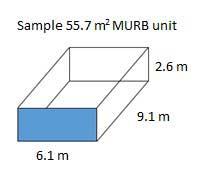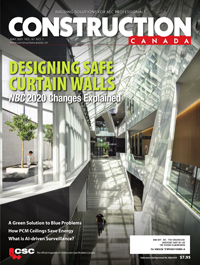Glass claddings for tall buildings

A simplified 55.7-m2 (600-sf) high-rise MURB unit is shown in Figure 5. The three interior walls are windowless and natural light enters the suite solely from one direction. Each interior wall, floor, and ceiling is perfectly insulated since the temperature on both sides is approximately the same.
Under SB-10, the WWR is calculated on a whole-building versus living-unit basis, so the interior walls are not included in the WWR calculation. The equation is:
This is inconsistent with the WWR calculation using SB-12, as it does not consider the number of units in the building and the individual living unit’s access to light. If SB-12 (attached homes) is used, 100 per cent windows on the exterior wall would represent only a 20 per cent WWR for the unit in Figure 5. As previously mentioned, a 20 per cent WWR is allowable in the prescriptive code for a low-rise residential building (i.e. single living unit) as calculated under SB-12.
Effective window-to-wall ratio
To address this inconsistency in the codes, the effective window-to-wall ratio (EWWR) metric has been introduced by researchers at Building Tall Research Centre at the University of Toronto. It defines the window-to-wall ratio of a MURB unit within the confines of the living space from the perspective of the occupant. Like SB-12, the EWWR considers all perimeter walls of a living unit. The EWWR calculation is:

The EWWR of the simplified unit with the corresponding whole-building WWRs is described in Figure 6.
If this simplified unit was designed to meet the SB-10 prescriptive 40 per cent WWR requirement, the unit would have an eight per cent EWWR for a side unit and a 20 per cent EWWR for a corner unit. This example shows, from the occupants’ perspective, the WWR of their living unit is likely much smaller than the building’s WWR and even much less than what they would have in a low-rise living unit if the current prescriptive code were to be followed.
While the scope of this paper only considers the differences in the local building codes, tall buildings around the world have traditionally been constructed for commercial use—therefore, the codes controlling their construction and operation are often more oriented toward nonresidential buildings. However, with the global intensification of cities and the need for high-rise residential towers, the codes around the world need to realize the unique needs and challenges of these tall communities.






